The Influence of Iron Content on the Porosity of AlSi9 Alloy Intended for Alfining Piston Ring Inserts
Abstract
1. Introduction
- Metal shrinkage during casting cooling, which causes a negative pressure of the liquid phase in the zone of dendrite growth of the solid-solution α(Al)—Darcy’s law [28];
- Superheating temperature of the liquid alloy above the temperature Tliq.;
- Speed of the crystallization front;
- Temperature gradient;
- Range of the crystallization difference between temperatures Tliq. and Tsol. and crystallization time;
- Processes of refining the dendrites of the solid solution of α(Al) with titanium and boron mordants introduced separately or together;
- Processes for the modification of silicon crystals in a two-component eutectic system α(Al) + β(Si) (e.g., with strontium).
- Porosity formation is caused by the presence of brittle, “plate-like” precipitates of the β-Al5FeSi phase in Al–Si alloys, mainly with an Fe content of over 0.4 wt.%. These precipitates, especially when they crystallize initially, block the interdendritic flow channels of the liquid alloy, and with a high iron content, they facilitate the nucleation of eutectic silicon crystals. This causes the deterioration of interdendritic permeability, especially that of secondary dendrites, and, consequently, an increase in the porosity of the castings [5,36,40,41,42,43];
- The formation of thin, two-layer oxide films, which exhibit a spherical or flattened shape during casting. This is due to the turbulent flow of the alloy, causing them to become tangled and folded. Campbell called them “bifilms” [19,20,44,45,46,47]. These oxides, due to the high sintering temperature (approx. 1900 °C) and the lack of wettability, especially on wavy, rough surfaces, are disconnected from each other, constituting a kind of “empty space” in the liquid. Once the alloy solidifies, these air gaps constitute crack and pore concentrators. The exact way in which these “bifilms” are formed is described in paper [48] using the example of the A356 alloy (Al-7Si-0.3Mg).
- It is based on the Al–Si alloy, which is used in real production processes, i.e., the “alfining” of cast iron ring inserts in engine pistons;
- All tests were verified in conditions of continuous industrial production;
- The obtained results can be used as guidelines for obtaining the correct connection of other bimetallic castings such as iron–aluminium alloys;
- It increases knowledge about the growing percentage of aluminium alloy recycling.
1.1. Piston Ring Inserts
- Reduce the temperature of the piston fire zone;
- Increase the tribological resistance of the upper ring zone of the piston;
- Improve the service life of piston rings, especially the compression ring;
- Increase the tightness between the compression ring and the cylinder liner;
- Prevent the compression ring from chipping;
- Improve combustion efficiency in the working chamber of the combustion engine.
1.2. Problem Statement
2. Aim and Scope of the Research
- Assessing the percentage of casting defects in the insert–piston connection;
- Determining the causes of defects;
- Examining the microstructure of the insert–piston connection;
- Summarizing and drawing conclusions.
3. Materials and Research Methods
3.1. The Alfining Piston Ring Inserts
- Tearing of the upper (U) surface of the insert;
- Tearing of the bottom (B) surface of the insert.
3.2. Microstructure Studies
4. Results
4.1. Results of Chemical Composition
4.2. Results of Iron Content in the AlSi9 Alloy
- Identify iron phases and assess their impact on the quality of the connection: cast iron insert–Al–Si alloy;
- Assess the impact of porosity on the quality of the connection;
- Demonstrate a cause-and-effect relationship between the iron content and the porosity in the layer connecting the insert with the piston made of the AlSi11Cu4Ni3Mg alloy.
- Group 1—pistons with an insert alfined using the AlSi9 alloy before 3 h. The percentage of defective products in this group is minimal.
- Group 2—pistons with an insert alfined using the AlSi9 alloy from 3.1 to 6 h. The percentage of defective products in this group is acceptable, but corrective actions in the piston production process are required.
- Group 3—pistons with an insert alfined using the AlSi9 alloy from 6.1 to 9 h. The percentage of defective products is unacceptable.
- Group 4—pistons with an insert alfined using the AlSi9 alloy from 9.1 to 12 h. The percentage of defective products is unacceptable due to abnormally high rejection.
4.3. Results of the Metallographic Investigation
- For the first group of pistons (up to approx. 0.59 wt.% Fe in the AlSi9 alloy), few precipitates of iron phases were found in the area where the insert is connected to the piston. However, these phases did not negatively affect the connection.
- For the second group of pistons (from 0.6 to 1.0 wt.% Fe in the AlSi9 alloy), precipitates of iron phases were found in the area where the insert is connected to the piston. Their length ranged from approx. 100 to 400 μm.
- For the third group of pistons (from 1.01 to 1.84 wt.% Fe in the AlSi9 alloy), numerous long (from approx. 400 to 650 μm) and thick (from approx. 8 to 10 μm) precipitates of iron phases were found in the area where the insert is connected to the piston. A few porosity clusters were also found.
- For the fourth group of pistons (over 1.85 wt.% Fe in the AlSi9 alloy), numerous long (over 650 μm) and thick (from approx. 10 to 14 μm) precipitates of iron phases were found in the area where the insert is connected to the piston iron. Numerous porosity clusters were also found.
4.4. Analysis of the Relationships Between the Iron Content, the Amount of the β-Al5FeSi Phase and Porosity in the AlSi9 Alloy
5. Summary
- An increase in the iron content in the AlSi9 alloy and therefore in the amount of the β-Al5FeSi phase;
- The accompanying porosity clusters, mainly of a shrinkage nature.
6. Conclusions
- Using the AlSi9 alloy for more than 6 h of alfining cast iron ring inserts causes an increase in the iron content (more than 1.0 wt.%), which crystallizes in the form of the β-Al5FeSi phase.
- The β-Al5FeSi phase, with an unfavourable lamellar structure, is the cause of cracks and, above all, the reason for a significant increase in shrinkage porosity.
- Up to approx. 0.59 wt.% Fe, the volume fraction of the β-Al5FeSi phase and the volume fraction of shrinkage pores have low values—up to approx. 3%.
- A further increase in the iron content (more than 0.6 wt.%) increases the volume fraction of the β-Al5FeSi to 18% and the shrinkage porosity to 14%.
- The main cause of poor insert–piston connection is the β-Al5FeSi phase and the accompanying shrinkage porosity. This microstructure of the layer connecting the insert with the piston results in a very high percentage of defective products.
- The influence of the so-called oxide “bifilms” on porosity has not been confirmed.
Author Contributions
Funding
Institutional Review Board Statement
Informed Consent Statement
Data Availability Statement
Conflicts of Interest
References
- Kammer, C. Aluminium Handbook: Vol. 1: Fundamentals and Materials; Beuth Verlag GmbH: Berlin, Germany, 2011. [Google Scholar]
- King, F. Aluminum and Its Alloys; Halstead Press: Ultimo, NSW, Australia, 1987. [Google Scholar]
- Szczucki, M.; Piątkowski, J.; Czerepak, M. Effect of iron phases crystallization on the durability of the bimetallic connection between ring inserts and the piston casting. Arch. Foundry Eng. 2023, 23, 58–65. [Google Scholar] [CrossRef]
- Davis, J.R. Aluminum and Aluminum Alloys. In ASM Specialty Handbook; ASM International: Materials Park, OH, USA, 1993. [Google Scholar]
- Taylor, J.A. Iron-containing intermetallic phases in Al-Si based casting alloys. Procedia Mater. Sci. 2012, 1, 19–33. [Google Scholar] [CrossRef]
- Ferraro, S.; Fabrizi, A.; Timelli, G. Evolution of sludge particles in secondary die-cast aluminium alloys as function of Fe, Mn and Cr contents. Mater. Chem. Phys. 2015, 153, 168–179. [Google Scholar] [CrossRef]
- Seifedine, S.; Svensson, I.L. The influence of Fe and Mn content and cooling rate on the microstructure and mechanical properties of A380-die casting alloys. Metall. Sci. Technol. 2009, 27, 11–20. [Google Scholar]
- Guo, H.M.; Yang, X.J.; Wang, J.X. Pressurized solidification of semi-solid aluminum die casting alloy A356. J. Alloys Compd. 2009, 485, 812–816. [Google Scholar] [CrossRef]
- Samuel, A.M.; Samuel, F.H. Effect of alloying elements and dendrite arm spacing on the microstructure and hardness of an Al-Si-Cu-Mg-Fe-Mn (380) aluminium die-casting alloy. J. Mater. Sci. 1995, 30, 1698–1708. [Google Scholar] [CrossRef]
- Bösch, D.; Pogatscher, S.; Hummel, M.; Fragner, W.; Uggowitzer, P.J.; Göken, M.; Höppel, H.W. Secondary Al-Si-Mg high-pressure die casting alloys with enhanced ductility. Metall. Mater. Trans. A 2015, 46, 1035–1045. [Google Scholar] [CrossRef]
- Belov, N.A.; Aksenov, A.A.; Eskin, D.G. Iron in Aluminum Alloys: Impurity and Alloying Element; Taylor & Francis Inc.: New York, NY, USA, 2002. [Google Scholar]
- Mbuya, T.O.; Odera, B.O.; Ng’ang’a, P.S. The influence of Fe on castability and properties of Al-Si alloys: Literature review. Int. J. Cast Met. Res. 2003, 16, 451–465. [Google Scholar] [CrossRef]
- Shabestari, S.G. The Effect of iron and manganese on the formation of intermetallic compounds in Al-Si alloys. Mater. Sci. Eng. A 2004, 383, 289–298. [Google Scholar] [CrossRef]
- Ebhota, W.S.; Tien-Chien, J. Intermetallics formation and their effect on mechanical properties of Al-Si-X alloys. In Intermetallic Compounds—Formation and Applications; IntechOpen: London, UK, 2014. [Google Scholar] [CrossRef]
- Guisen, L.; Mingyu, G.; Dongyue, X.; Jian, W. Structures and mechanical properties of Al-Al2Cu interfaces. J. Miner. Met. Mater. Soc. 2019, 71, 1200–1208. [Google Scholar] [CrossRef]
- Hurtalowa, L.; Tillova, E.; Chalupova, M. Identyfication and analysis of intermetallic phases in age-hardened recycled AlSi9Cu3 alloy. Arch. Mech. Eng. 2012, 59, 385–393. [Google Scholar] [CrossRef]
- Gaber, A.; Gaffar, M.A.; Mustafa, M.S.; Abo Zeid, E.F. Precipitation kinetics of Al-1.12Mg2Si-0.35Si and Al.-1.07Mg2Si-0.33 Cu alloys. Metall. Mater. Trans. A 2005, 36, 2059–2065. [Google Scholar]
- Piątkowski, J. Crystallization of casting aluminum alloys. Arch. Foundry Eng. 2021. [Google Scholar]
- Xinjin, C.; Cao, X.; Campbell, J. Morphology of β-Al5FeSi phase in Al-Si cast alloys. Mater. Trans. 2006, 47, 1303–1312. [Google Scholar]
- Mahta, M.; Emamy, M.; Cao, X.; Campbell, J. Overview of β-Al5FeSi phase in Al-Si cast alloys. In Materials Science Research Trends; NRC Publications Archive: Ottawa, ON, Canada, 2008; pp. 251–271. [Google Scholar]
- Pennors, A.; Samuel, A.M.; Samuel, F.H.; Doty, H.W. Precipitation of β-Al5FeSi iron intermetallic in Al-6%Si-3.5%Cu (319) type alloys: Role of Sr and P. AFS Trans. 1998, 106, 251–264. [Google Scholar]
- Mikołajczyk, P.; Ratke, L. Three dimensional morphology of β-Al5FeSi intermetallics in AlSi alloys. Arch. Foundry Eng. 2015, 15, 47–50. [Google Scholar] [CrossRef]
- Cais, J.; Weiss, V.; Svobodova, J. Relation Between Porosity and Mechanical Properties of Al-Si Alloys Produced by Low-pressure Casting. Arch. Foundry Eng. 2014, 14, 97–102. [Google Scholar]
- Elwin, L.; Rooy, E. Mechanisms of porosity formation in aluminium. Mod. Cast. 1992, 82, 34–36. [Google Scholar]
- Bruna, M.; Sládek, A.; Kucharčík, L. Formation of Porosity in Al-Si Alloys. Arch. Foundry Eng. 2012, 12, 5–8. [Google Scholar] [CrossRef]
- Monroe, R. Porosity in Castings. AFS Trans. 2005, 04, 205–245. [Google Scholar] [CrossRef]
- Fang, Q.T.; Anyalebechi, P.N. Effects of Solidification Conditions on Hydrogen Porosity Formation in Aluminium Alloys; Light Metals, Minerals, Metals and Materials Society: Warrendale, PA, USA, 1988; pp. 477–486. [Google Scholar]
- Darcy-Peaceman, D.W. Fundamentals of Numerical Reservoir Simulation, 1st ed.; Elsevier: Amsterdam, The Netherlands, 1977; ISBN 9780080868608. [Google Scholar]
- Samuel, A.M.; Samuel, E.; Songmene, V.; Samuel, F.H. A Review on Porosity Formation in Aluminum-Based Alloys. Materials 2023, 16, 2047. [Google Scholar] [CrossRef] [PubMed]
- Carlson, K.D.; Lin, Z.; Beckermann, C. Modeling the Effect of Finite-Rate Hydrogen Diffusion on Porosity Formation in Aluminum Alloys. Metall. Mater. Trans. B 2007, 38, 541–555. [Google Scholar] [CrossRef]
- Ambat, R.; Dwarakadasa, E.S. Effect of hydrogen in aluminium and aluminium alloys: A review. Bull. Mater. Sci. 1990, 19, 103–114. [Google Scholar] [CrossRef]
- Samuel, A.; Zedan, Y.; Doty, H.; Songmene Samuel, F.H. Overview of the main sources of porosity in Al-Si cast alloys. Adv. Mater. Sci. Eng. 2021, 2021, 1921603. [Google Scholar] [CrossRef]
- Anyalebechi, P.N. Hydrogen-induced gas porosity formation in Al–4.5 wt% Cu–1.4 wt% Mg alloy. J. Mater. Sci. 2013, 48, 5342–5353. [Google Scholar] [CrossRef]
- Zavadska, D.; Tillova, E.; Svesova, I.; Chalupova, M.; Kucharikova, L.; Belan, J. The effect of iron content on microstructure and porosity of secondary AlSi7Mg0.3 alloy. Period. Polytech. Transp. Eng. 2019, 47, 283–289. [Google Scholar] [CrossRef]
- Campbell, J.; Tiryakioglu, M. Review of effect of P and Sr modification and porosity development in Al-Si alloys. Mater. Sci. Technol. 2010, 26, 262–268. [Google Scholar] [CrossRef]
- Tiedje, N.S.; Taylor, J.A.; Easton, M.A. A new multi-zone model for porosity distribution in Al-Si alloy castings. Acta Mater. 2013, 61, 3037–3049. [Google Scholar] [CrossRef]
- Gagnon, D.; Samuel, A.M.; Samuel, F.H.; Abdelaziz, M.H.; Doty, H.W. Melt Treatment-Porosity Formation Relationship in Al-Si Cast Alloys. In Casting Processes and Modelling of Metallic Materials; IntechOpen: London, UK, 2021. [Google Scholar]
- Mohamed, A.M.A.; Samuel, E.; Zedan, Y.; Samuel, A.M.; Doty, H.W.; Samuel, F.H. Intermetallics Formation during Solidification of AlSiCuMg Cast Alloys. Materials 2022, 15, 1335. [Google Scholar] [CrossRef]
- Piątkowski, J.; Roskosz, S.; Stach, S. The Influence of Selected High-Pressure Die Casting Parameters on the Porosity of EN AB-46000 Alloy. Adv. Sci. Technol. Res. J. 2024, 18, 361–371. [Google Scholar] [CrossRef]
- Hejne, M.; Piątkowski, J.; Wieszała, R. Defect analysis of EN AC-43000 alloy die casting using the Patero-Lorenz diagram. Sci. Pap. Silesian Univ. Technol. 2023, 172, 289–297. [Google Scholar] [CrossRef]
- Taylor, J.A. The Effect of Iron in Al-Si Cast Alloys. Available online: https://www.researchgate.net/publication/43457790 (accessed on 1 September 2024).
- Dinnis, C.M.; Taylor, J.A.; Dahle, A.K. Porosity Formation and Eutectic Growth in Al-Si-Cu-Mg Alloys Containing Iron and Manganese. In Proceedings of the 9th International Conference on Aluminium Alloys 2004, Brisbane, QLD, Australia, 2–5 August 2004. [Google Scholar]
- Lu, L.; Dahle, A.K. Iron-Rich Intermetallic Phases and Their Role in Casting Defect Formation in Hypoeutectic Al-Si Alloys. Metall. Mater. Trans. A 2005, 36, 819–835. [Google Scholar]
- Sigworth, G.; Campbell, J. The Modification of Al-Si Casting Alloys: Important Practical and Theoretical Aspects. Int. J. Met. 2009, 3, 65–78. [Google Scholar] [CrossRef]
- Mahta, M.; Emamy, M.; Daman, A.; Keyvani, A.; Campbell, J. Precipitation of Fe-rich intermetallics in Cr and Co modified A413 alloy. Int. J. Cast Met. Res. 2005, 18, 73–79. [Google Scholar] [CrossRef]
- Kral, M.V. A crystallographic identification of intermetallic phases in Al-Si alloys. Mater. Lett. 2005, 59, 2271–2276. [Google Scholar] [CrossRef]
- Campbell, J. Complete Casting Handbook: Metal Casting Processes, Metallurgy, Techniques and Design, 2nd ed.; Elsevier: Amsterdam, The Netherlands, 2015. [Google Scholar]
- Park, J.M. Behaviours of Bifilms in A356 Alloy During Solidification: Developing Observation Techniques with 3-D Micro X-ray Tomography. Master’s Thesis, The University of Birmingham, Birmingham, UK, 2009. Available online: https://etheses.bham.ac.uk/id/eprint/745/1/Park10Mres.pdf (accessed on 1 September 2024).
- Stone, R. Introduction to Internal Combustion Engines, 3rd ed.; SEA and Macmillan: New York, NY, USA, 2002. [Google Scholar]
- Hassan, A.A.; Nuraini, A.A.; Hairuddin, A.A. The use of different types of piston in an HCCI engine: A review. Int. J. Automot. Mech. Eng. 2017, 14, 4348–4368. [Google Scholar] [CrossRef]
- Crolla David, A. Automotive Engineering. Powertrain, Chassis System and Vehicle Body; Elsevier: Amsterdam, The Netherlands, 2009; Available online: https://www.elsevierdirect.com/9781856175777 (accessed on 20 September 2024).
- Adil, H.; Gerguri, S.; Durodola, J.; Audebert, F.; Bonatesta, F.; Saporiti, F. Evolution of Materials for Internal Combustion Engines Pistons. Int. J. Res. Rev. 2023, 10, 203–214. [Google Scholar] [CrossRef]
- European Aluminium Association. Applications–Power train–Pistons. In The Aluminium Automotive Manual; European Aluminium Association: Brussels, Belgium, 2011. [Google Scholar]
- Heywood, J.B. Internal Combustion Engine Fundamentals, 1st ed.; McGraw-Hill Inc.: Singapore, 1989. [Google Scholar]
- Huang, X.; Liu, C.; Lv, X.; Liu, G.; Li, F. Aluminum alloy pistons reinforced with SiC fabricated by centrifugal casting. J. Mater. Process. Technol. 2011, 211, 1540–1546. [Google Scholar] [CrossRef]
- Hovorun, T.P.; Berladir, K.V.; Pererva, V.I.; Rudenko, S.G.; Martynov, A.I. Modern materials for automotive industry. J. Eng. Sci. 2017, 4. [Google Scholar] [CrossRef]
- Sharon, F. Additive Manufacturing Technology: Potential Implications for U.S. Manuf. Competitiveness. J. Int. Commer. Econ. 2014, 6, 40. [Google Scholar]
- Miller, W.S.; Zhuang, L.; Bottema, J.; Wittebrood, A.J.; Smet, P.D.; Haszler, A.; Vieregge, A. Recent development in aluminum alloys for the automotive industry. Mater. Sci. Eng. 2000, 280, 37–49. [Google Scholar] [CrossRef]
- Robles-Hernandez, F.C.; Herrera Ramirez, J.M.; Mackay, R. Al-Si Alloys. Automotive, Aeronautical and Aerospace Applications; Springer: Berlin/Heidelberg, Germany, 2018. [Google Scholar]
- Alam, T.; Ansari, A.H. Review on Aluminium and its Alloys for Automotive Applications. Int. J. Adv. Technol. Eng. Sci. 2017, 5, 278–294. [Google Scholar]
- Mahle Performance. Piston Rings. Weatherly Index 020. Catalog No. PR-40-22. 2022. Available online: https://www.mahle-aftermarket.com/media/local-media-north-america/pdfs-&-thumbnails/catalogs-and-literature/pistons-and-rings/pr-40-22.pdf (accessed on 1 September 2024).
- Acar, A.F.; Ozturk, F.; Bayrak, M. Effects of variations in alloy content and machining parameters on the strength of the intermetallic bonding between a diesel piston and a ring carrier. Mater. Technol. 2010, 44, 391–395. [Google Scholar]
- Czerepak, M. Technological Methods of Reducing the Consumption of Alloy for Alfinization of Ring Inserts in Piston Castings for Combustion Engines. Ph.D. Thesis, Silesian University of Technology, Gliwice, Poland, 2023. [Google Scholar]
- Piątkowski, J.; Czerepak, M. The crystallization of the AlSi9 alloy designed for the alfin processing of ring supports in engine pistons. Arch. Foundry Eng. 2020, 20, 65–70. [Google Scholar] [CrossRef]
- Manasijević, S.; Dolić, N.; Djurdjevic, M.; Mišić, N.; Davitkov, N. The intermetallic bonding between a ring carrier and aluminiumpiston alloy. Rev. Metal. 2015, 51, e048. [Google Scholar] [CrossRef]
- Schneider, C.A.; Rasband, W.S.; Eliceiri, K.W. NIH Image to ImageJ: 25 years of image analysis. Nat. Methods 2012, 9, 671–675. [Google Scholar] [CrossRef]
- Roskosz, S. Quantitative characterization of shrinkage and gas pores in turbine blades made of MAR M247 and IN 713C superalloy. In Proceedings of the 9th International Conference on Stereology and Image Analysis in Materials, Zakopane, Poland, 3–6 September 2012; pp. 64–69. [Google Scholar] [CrossRef]
- Roskosz, S. Quantitative evaluation of porosity in turbine blades made of IN713C superalloy after hot isostatic pressing. Arch. Metall. Mater. 2017, 62, 253–258. [Google Scholar] [CrossRef]
- Taylor, J.A.; Schaffer, G.B.; StJohn, D.H. The Role of Iron in the Formation of Porosity in Al-Si-Cu Based Casting Alloys: Part I. Initial Experimental Observations. Metall. Mater. Trans. A 1999, 30, 1643–1650. [Google Scholar] [CrossRef]
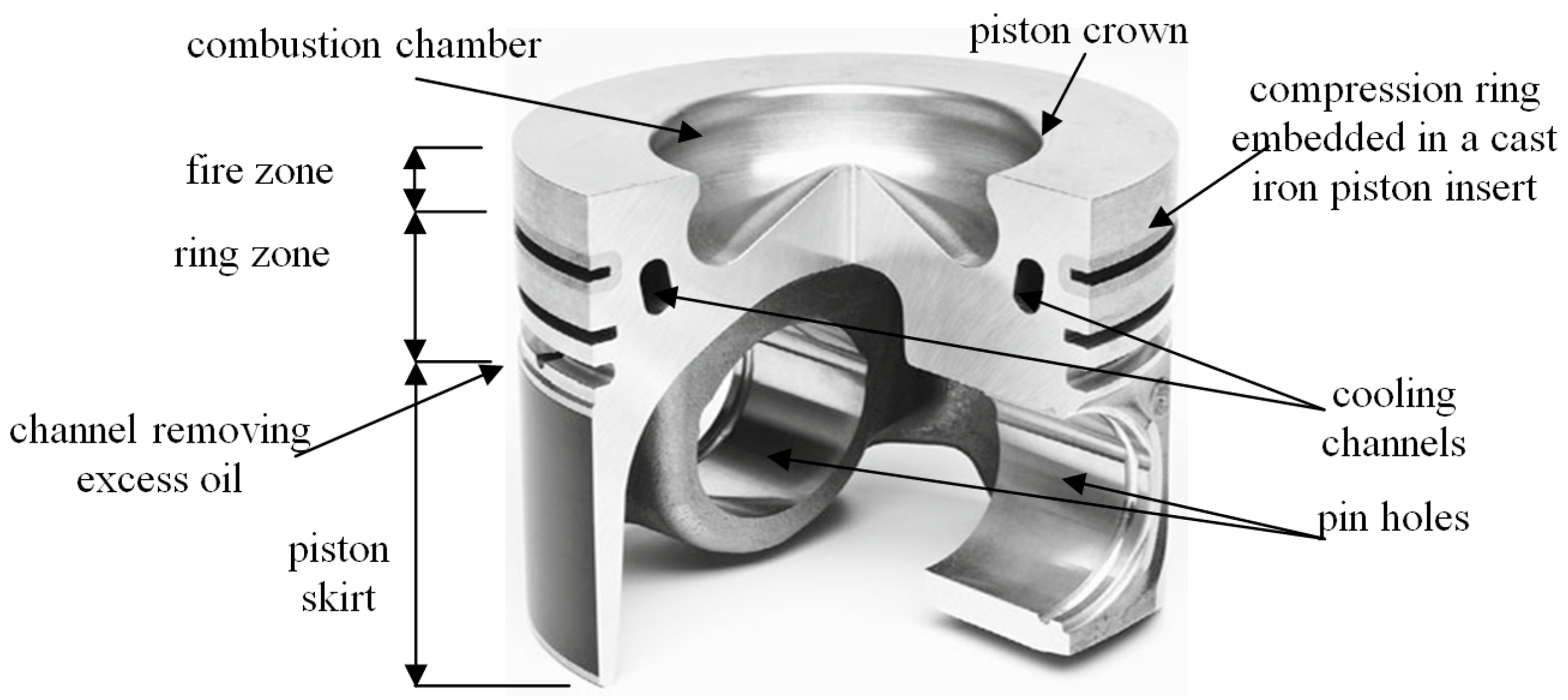

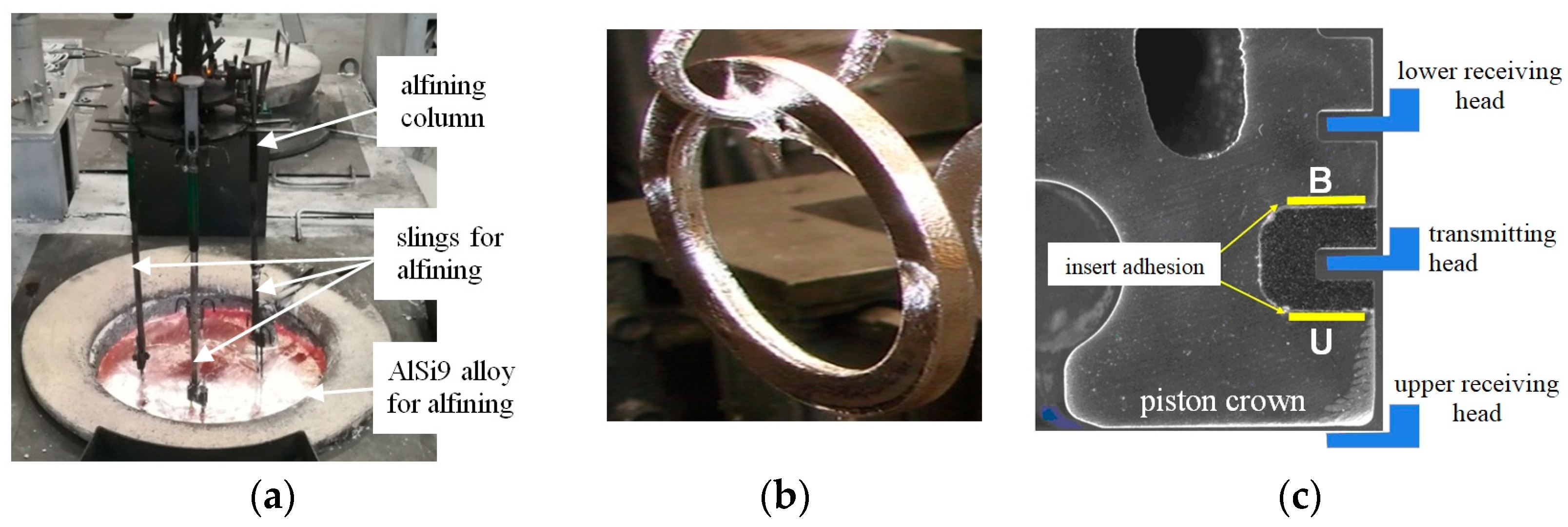
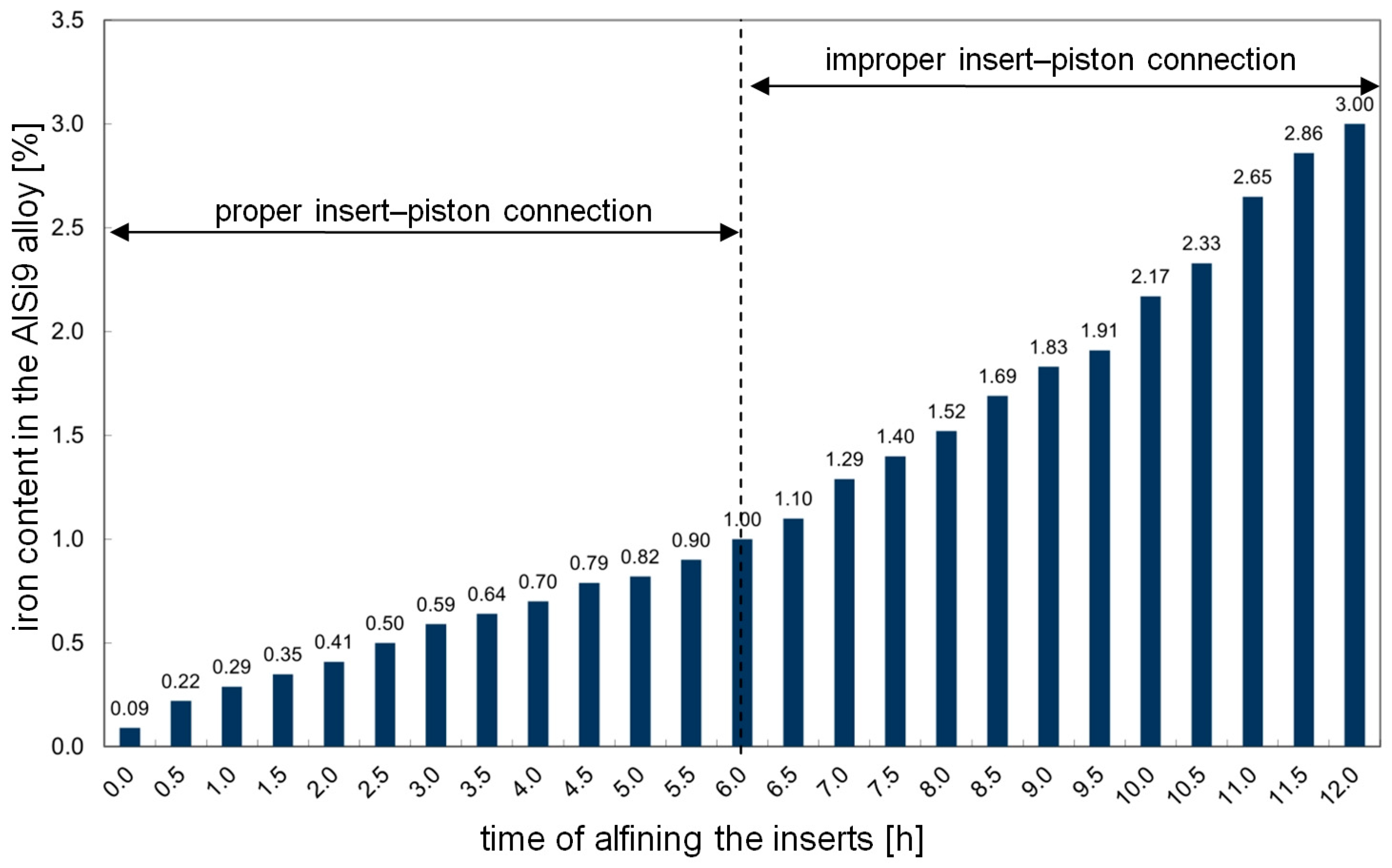
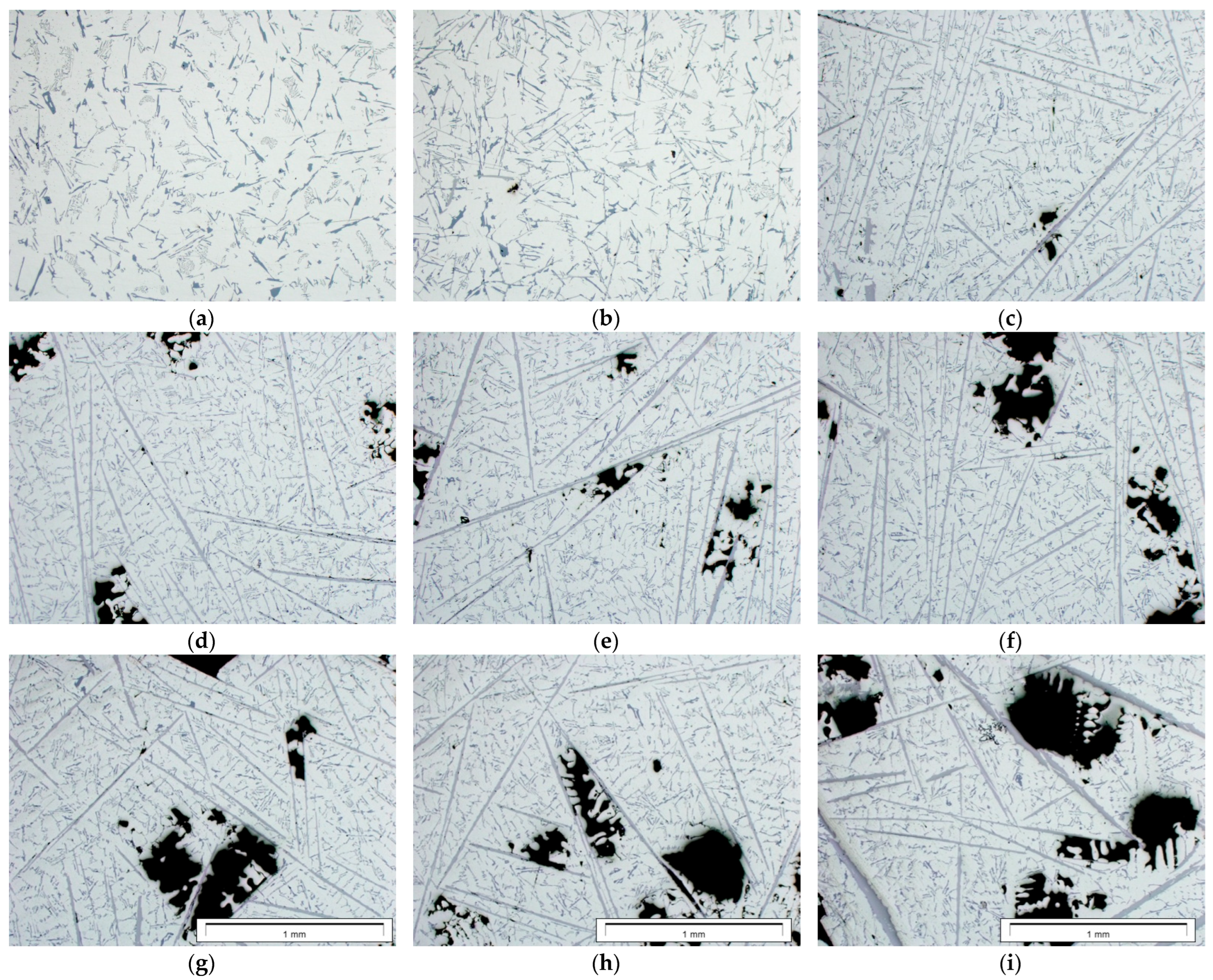

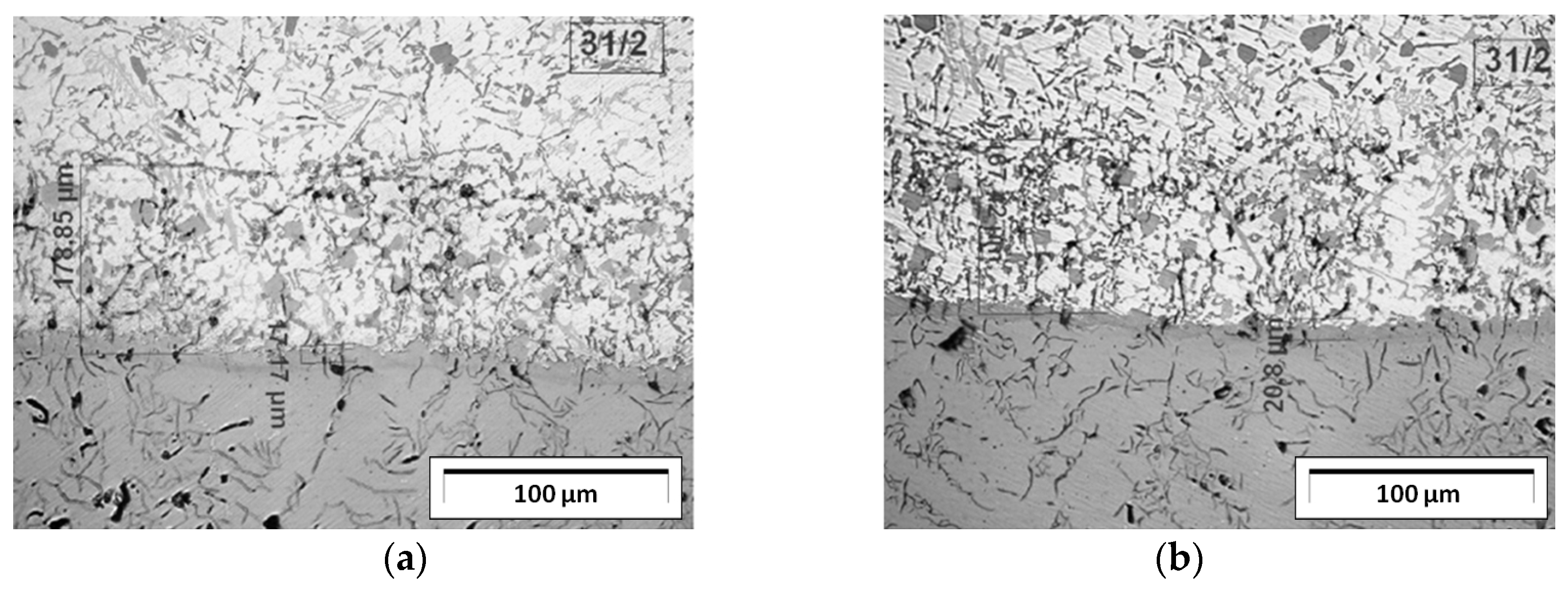
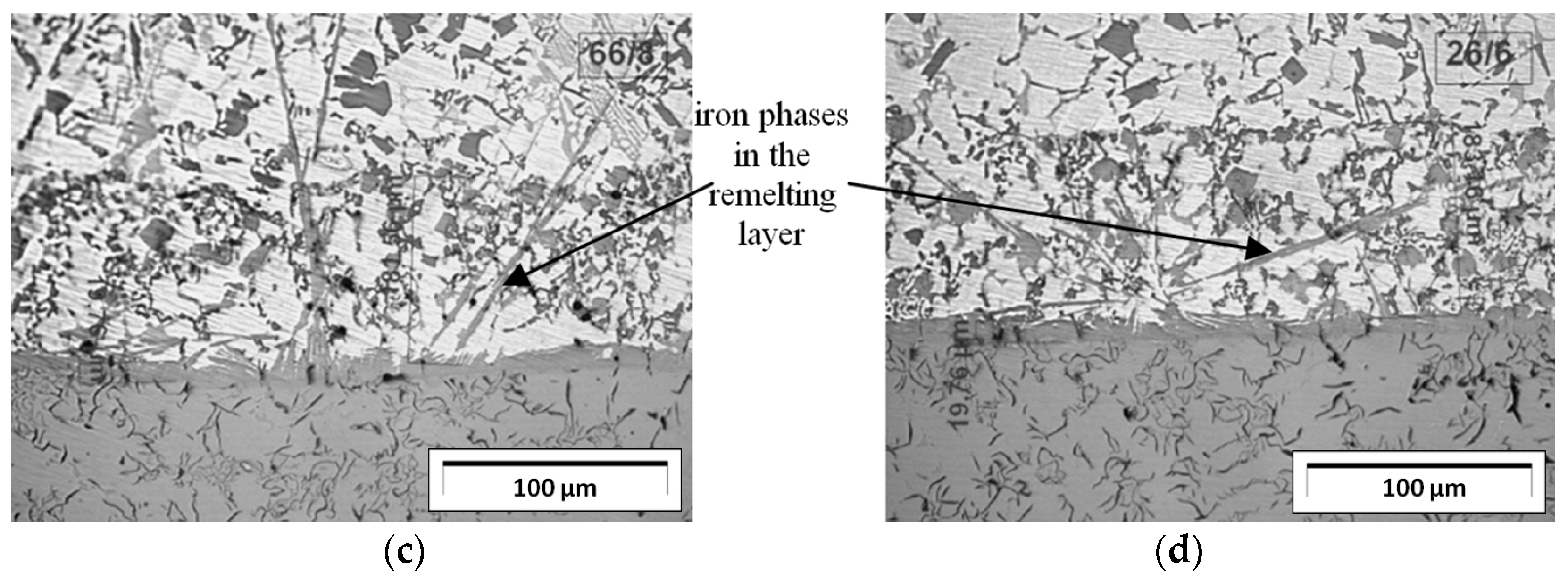
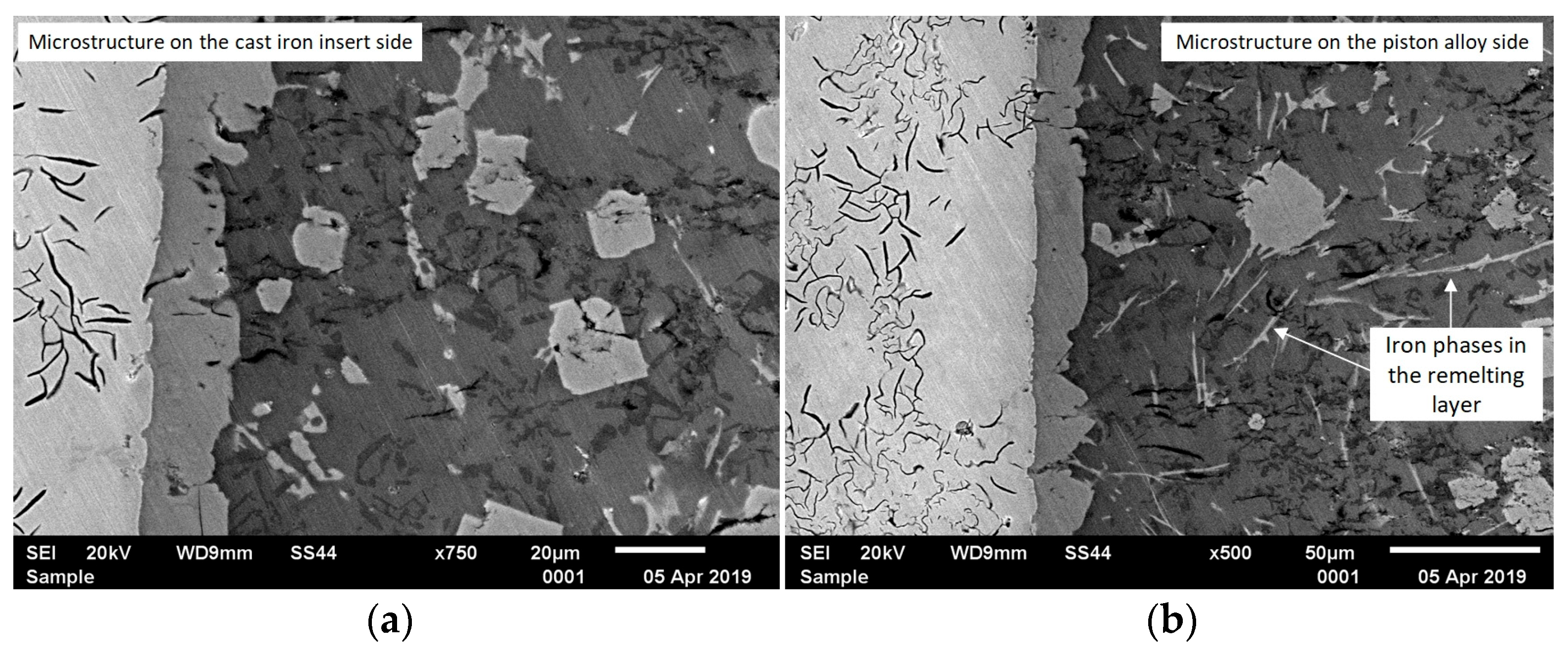
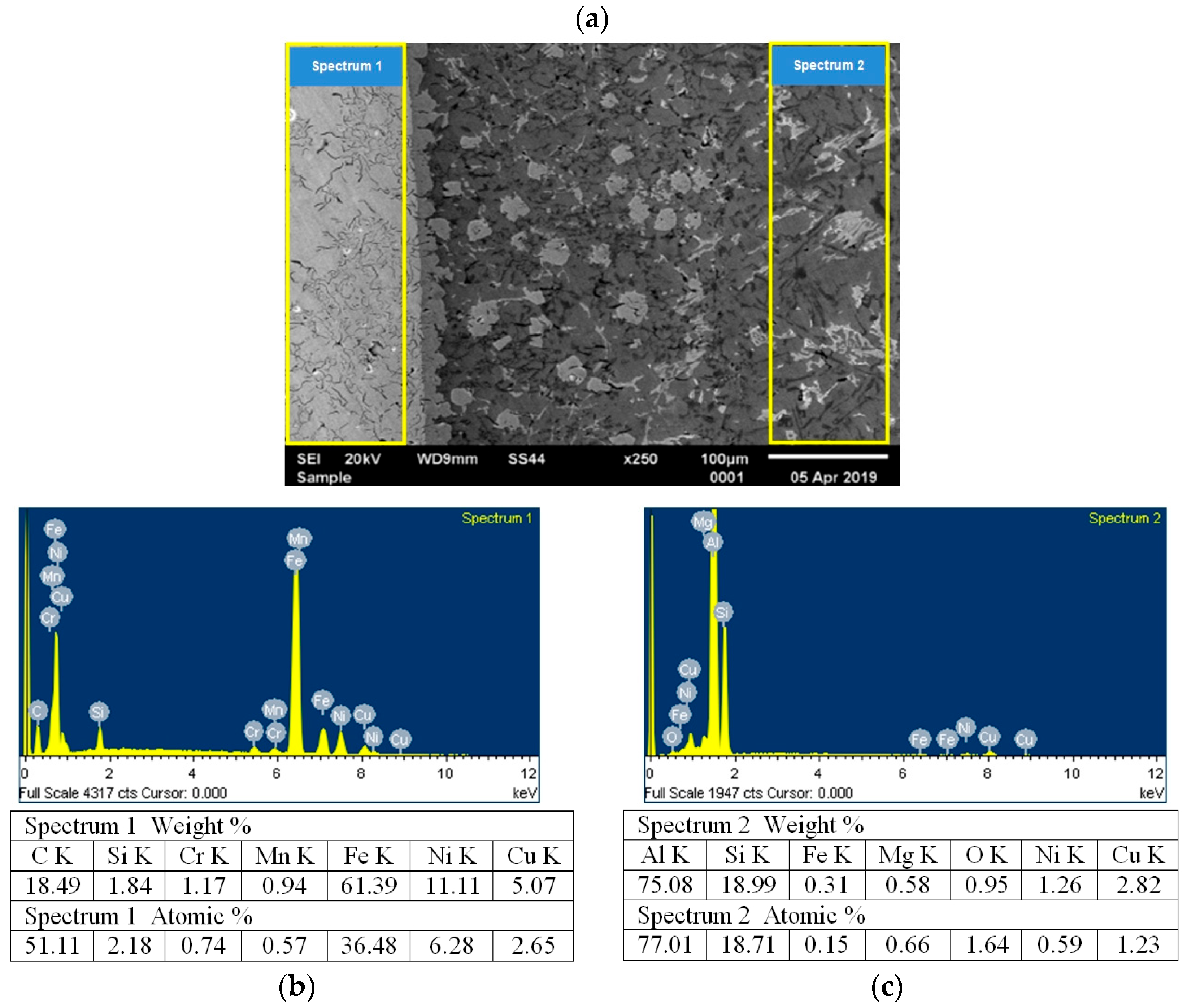
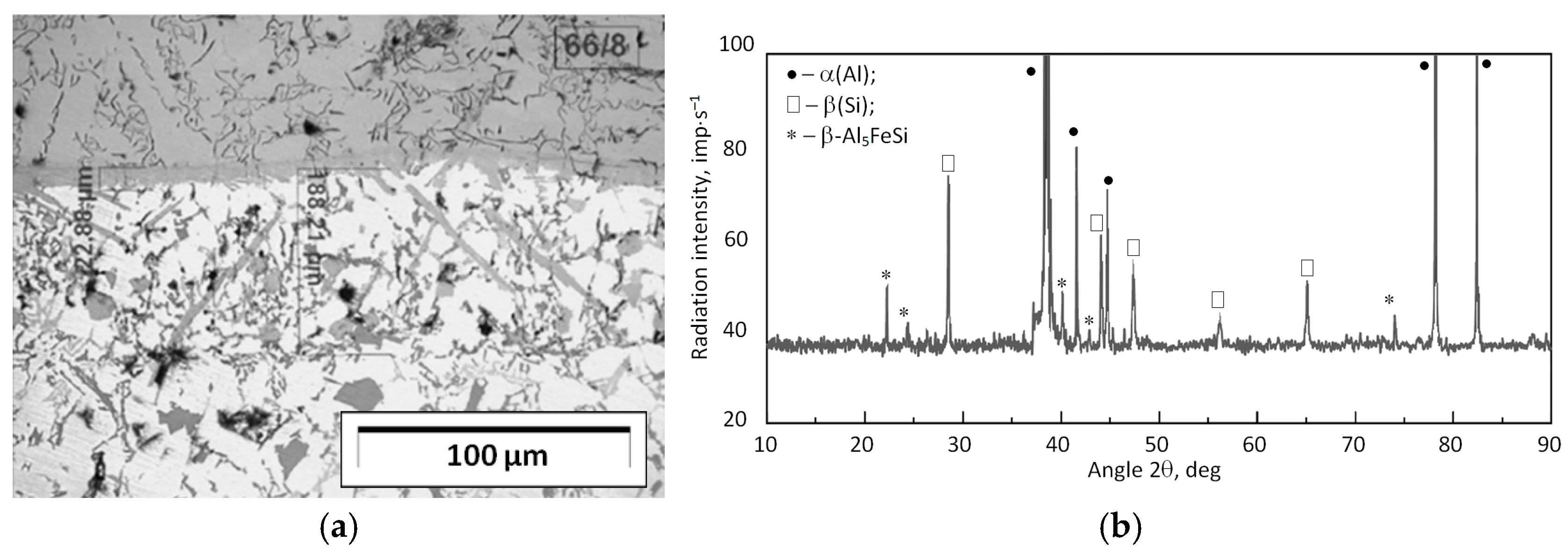


| Cast Iron Designation | Element Content, wt.% | |||||||||
|---|---|---|---|---|---|---|---|---|---|---|
| C | Si | Mn | Ni | Mg | Cr | P | S | Cu | Fe | |
| GJLA-XNiCuCr15-6-2 (DIN EN 13835) | 2.4–2.8 | 1.8–2.4 | 1.0–1.4 | 14.0–17.0 | - | 1.0–1.6 | max. 0.08 | max. 0.10 | 6.5–7.0 | The rest |
| Element Content, wt.% | |||||||||||||
|---|---|---|---|---|---|---|---|---|---|---|---|---|---|
| Si | Cu | Mg | Ni | Fe | Mn | Zn | Ti | Pb | Zr | V | Sn | Cr | P ppm |
| 10.0–11.5 | 3.5–4.3 | 0.5–1.0 | 2.2–3.2 | Up to 0.5 | Up to 0.2 | Up to 0.1 | Up to 0.05 | Up to 0.05 | Up to 0.05 | Up to 0.03 | Up to 0.05 | Up to 0.03 | 60–100 |
| Element Content, wt.% | |||||||
|---|---|---|---|---|---|---|---|
| Si | Mg | Cu | Mn | Fe | Ni | Zn | Others |
| 8.5–10.00 | up to 0.03 | up to 0.20 | up to 0.12 | up to 0.15 | up to 0.05 | up to 0.05 | up to 0.02 |
Disclaimer/Publisher’s Note: The statements, opinions and data contained in all publications are solely those of the individual author(s) and contributor(s) and not of MDPI and/or the editor(s). MDPI and/or the editor(s) disclaim responsibility for any injury to people or property resulting from any ideas, methods, instructions or products referred to in the content. |
© 2024 by the authors. Licensee MDPI, Basel, Switzerland. This article is an open access article distributed under the terms and conditions of the Creative Commons Attribution (CC BY) license (https://creativecommons.org/licenses/by/4.0/).
Share and Cite
Piątkowski, J.; Roskosz, S.; Sapota, W.; Stach, S. The Influence of Iron Content on the Porosity of AlSi9 Alloy Intended for Alfining Piston Ring Inserts. Materials 2024, 17, 5181. https://doi.org/10.3390/ma17215181
Piątkowski J, Roskosz S, Sapota W, Stach S. The Influence of Iron Content on the Porosity of AlSi9 Alloy Intended for Alfining Piston Ring Inserts. Materials. 2024; 17(21):5181. https://doi.org/10.3390/ma17215181
Chicago/Turabian StylePiątkowski, Jarosław, Stanisław Roskosz, Wiktoria Sapota, and Sebastian Stach. 2024. "The Influence of Iron Content on the Porosity of AlSi9 Alloy Intended for Alfining Piston Ring Inserts" Materials 17, no. 21: 5181. https://doi.org/10.3390/ma17215181
APA StylePiątkowski, J., Roskosz, S., Sapota, W., & Stach, S. (2024). The Influence of Iron Content on the Porosity of AlSi9 Alloy Intended for Alfining Piston Ring Inserts. Materials, 17(21), 5181. https://doi.org/10.3390/ma17215181








